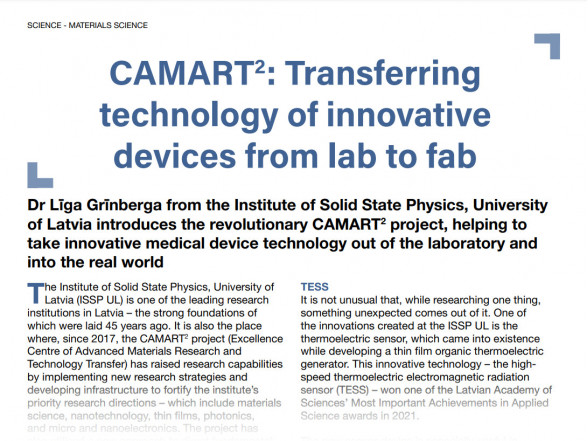In its Issue 12, 2022, the Innovation Platform published an article about CAMART2 and two of the latest innovative technology success stories – TESS or the high-speed thermoelectric electromagnetic radiation sensor, that has won one of the Latvian Academy of Sciences’ Most Important Achievements in Applied Science awards in 2021 and organ-on-a-chip.
The CAMART2 project has raised research capabilities by implementing new research strategies and developing infrastructure to fortify the institute’s priority research directions, including materials science, nanotechnology, thin films, photonics, and micro and nanoelectronics. The project has also utilized a new approach to direct fundamental research toward technological needs and industrial challenges. The set-up established within the framework of the CAMART2 has contributed to the development of advanced, unique, and commercializable technologies.
TESS is a sensor technology that measures high-speed laser power in wide spectral diapason from ultraviolet to far infrared light. Using such a sensor in various tools based on laser technology will allow them to be operated more effectively and faster and might also develop new possibilities. In laser surgery, the new sensor will allow for performing various surgeries more quickly and accurately. For example, endovenous ablation surgery can be done much quicker by controlling the power of each laser impulse and therefore administering the necessary dose in a shorter time and more precisely. One of the creators of TESS, Dr Mārtiņš Rutkis, said: “TESS once again confirmed my conviction that if someone is investigating a phenomenon or developing a specific product, they should be open-minded and ready for a completely unexpected opportunity to appear. And, when it happens, the researcher must be brave enough to take this new pathway to success.”
The unique organ-on-a-chip device is a miniature artificial organ or replica of an organ outside the human body. It is a polymer device with microchannels inside. It is called a chip because it is mostly made using semiconductor technology, the same technology that makes almost every modern electronic device possible. The organ-on-a-chip does not replace real organs but serves as a test model. There are several fields this technology could be applied in: pharmaceutical (drug and vaccine testing), production of food additives and pesticides (safety testing), and the space industry (determining the right combination of probiotics).
Dr Gatis Mozoļevskis, one of the researchers behind organ-on-a-chip technology, said: “This idea and field have an immense potential to revolutionize drug discovery and patient treatment processes, thereby paving the way towards more accessible healthcare to everyone. We are well-positioned to deliver the yet-unlocked potential of the technology.”
Innovation News Network brings its readers the latest science, research and innovation news from across the fields of digital healthcare, space exploration, e-mobility, biodiversity, aquaculture and much more.
The full story is available on pages 308-311:
https://edition.pagesuite.com/html5/reader/production/default.aspx?pubname=&pubid=04d7cc56-7256-4dd8-b0ee-8e89a8983584



